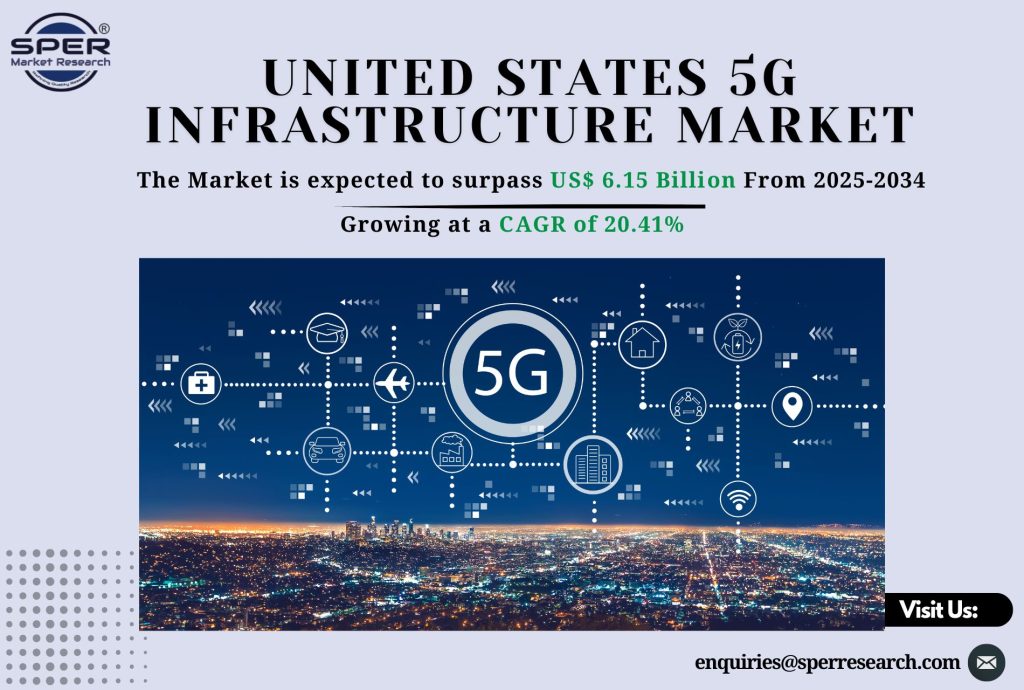United States 5G Infrastructure Market Trends, Share and Forecast 2034

5G infrastructure refers to the advanced network framework that supports fifth-generation wireless technology, enabling faster data speeds, lower latency, and greater connectivity compared to previous generations. This infrastructure includes new radio access networks (RAN), small cells, fiber optics, edge computing, and upgraded core networks designed to handle massive data traffic and support emerging technologies like IoT, autonomous vehicles, and smart cities. The deployment of 5G infrastructure is crucial for transforming communication, enhancing mobile broadband, and enabling real-time applications across industries. As businesses and consumers demand seamless, high-speed connectivity, investment in 5G infrastructure is accelerating globally, promising to revolutionize digital experiences and drive economic growth.
According to SPER Market Research, ‘United States 5G Infrastructure Market Size- By Communication Infrastructure, By Network Technology, By Network Architecture, By Frequency, By End User- Regional Outlook, Competitive Strategies and Segment Forecast to 2033’ the United States 5G Infrastructure Market is estimated to reach USD 6.15 billion by 2033 with a CAGR of 20.41%.
Drivers:
The 5G infrastructure market is fueled by the rising demand for faster, more reliable wireless networks to support the growth of data-intensive applications like IoT, augmented reality, virtual reality, and autonomous vehicles. Increased smartphone penetration and escalating mobile data usage worldwide compel telecom operators to upgrade their networks to 5G technology. Government initiatives aimed at digital transformation, smart city development, and Industry 4.0 further boost 5G deployment. Additionally, industries such as healthcare, manufacturing, and entertainment require low latency and high bandwidth solutions, driving infrastructure investments. Technological advancements and strategic collaborations among telecom providers and equipment manufacturers continue to accelerate network deployment, making 5G infrastructure essential for future connectivity and economic growth.
Download a Free Report Overview Now
Restraints:
The 5G infrastructure market faces several challenges that could slow its growth. High capital expenditure is required to build dense small cell networks and expand fiber optic connectivity, making deployment costly for service providers. Regulatory challenges, including delays in spectrum allocation and compliance requirements, create further obstacles. Security concerns around data privacy and cyber threats also deter rapid adoption. Additionally, the absence of global standards and issues with equipment interoperability complicate network integration. Public concerns about the potential health effects of 5G radiation, along with geopolitical tensions affecting supply chains and technology access, contribute to uncertainties in the market, limiting the pace of widespread 5G infrastructure rollout.
China leads the 5G infrastructure market due to its large-scale investments, rapid deployment of base stations, and strong government support for nationwide 5G rollout. Some key players are- Altiostar, Airspan Networks Holdings Inc., Casa Systems, Comba USA, Corning, Cisco Systems, Inc., Hewlett Packard Enterprise Development LP, Mavanir, NEC Corporation.
For More Information, refer to below link: –
United States 5G Infrastructure Market Growth
Related Reports:
Global Automotive Logistics Market Growth
Global Next-Generation Memory Market Growth
Follow Us –
LinkedIn | Instagram | Facebook | Twitter
Contact Us:
Sara Lopes, Business Consultant — USA
SPER Market Research
enquiries@sperresearch.com
+1–347–460–2899





